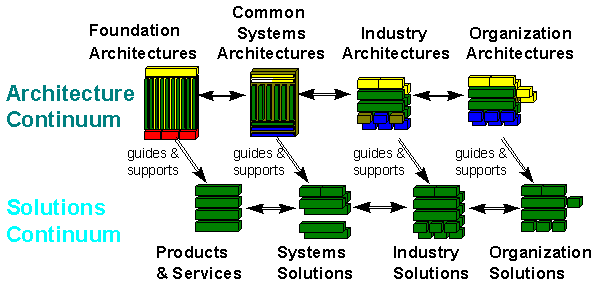TOGAF
The ITscout Blog has frequently referred to TOGAF, The Open Group's Architecture Framework, and in particular, the fact that TOGAF defines four types of architecture that are subsets of an overall Enterprise Architecture.
- Business Architecture
- Data Architecture
- Application Architecture
- Technology Architecture
TOGAF is a framework and a method for performing Enterprise Architecture. This makes it different from something like the Zachman Framework, which is a framework that is concerned only with content and not a method for building Enterprise Architectures.
TOGAF has two main components
- ADM -- Architecture Development Method
- The Enterprise Continuum
The Architecture Development Method

The ADM is a detailed, step-by-step method on how to build, maintain and implement an Enterprise Architecture. The outer circles of the graphic represent the major phases required to iteratively build and maintain Enterprise Architecture. As indicated by the circle at the center of the graphic, the ADM is continuously driven by the Requirements Management process. It is important to note that Requirements Management denotes, not a static set of requirements, but a dynamic process whereby requirements for Enterprise Architecture and subsequent changes to those requirements are identified, stored, and fed into and out of the relevant ADM phases in a cyclic fashion.
ADM forms the core of TOGAF. The business, information systems, and technology architectures are always aligned with requirements and related business goals.
The Enterprise Continuum

TOGAF's Enterprise Continuum specifies a progression for developing architectures and solutions using architecture building blocks and solution building blocks, in a continuous, iterative fashion. A building block is simply a grouping of functionality defined to meet business needs. An architecture building block is described with a general level of detail. Solution building blocks reflect real products or specific custom developments.
The relationship between the Architecture Continuum and the Solutions Continuum is one of guidance, direction, and support. You build an architecture by navigating the two continuums, from left to right, top to bottom, so that you are specifying architecture building blocks at each stage, and then the solution building blocks that implement them, and continuing rightward, building upon the solution and adding increasing detail.
The TOGAF ADM guides you through the left-to-right progression from the general architectures and solutions (on the left), to organization-specific ones (on the right).
A Foundation Architecture consists of architecture building blocks and corresponding standards that support a complete computing environment. TOGAF's pre-supplied Foundation Architecture consists of the Technical Reference Model and Standards Information Base.
A Common System Architecture is complete in terms of a particular problem domain, but incomplete in terms of the overall information system functionality. Examples of Common Systems Architectures are a Network Architecture, or a Security Architecture. A System Solution is an implementation of a Common System Architecture comprising a set of products and services.
Industry Architectures include pre-built, off-the-shelf architectures that have been developed for particular vertical industries. These often include pre-built data models and business processes. An Industry Solution is an implementation of an Industry Architecture.
|
 Site Feed
Site Feed

2 Comments:
Jeff,
I was looking for a good definition of Information Architecture, as that term is used in the context of developing and organizing the content that apppears on a Web site. I searched your blog, and since TOGAF looked as if it might be relevant, I searched the Web for more details.
Unfortunately, it seems (to be polite) only partly relevant. As best as I can tell from about an hour of browsing, TOGAF defines Data Architecture as "the structure of an organization's logical and physical data assets and data management resources". It is then planning (I think) to define "Information Architecture" as a step beyod Data Architecture -- see for example this and pp16-17 of this.
While this viewpoint makes complete sense to me given my database background, it does not seem to come close to incorporating what most of the world today thinks of as Information Architecture. See for example:
-- This Wikipedia definition.
-- This University of Minnesota reference material.
-- The table of contents of this book, an O'Reilly classic on the subject.
Does TOGAF not (yet?) apply to the WeB, and if not, why not? Are Web sites not yet part of "the enterprise" in the minds of those who run TOGAF?
As the guru of all things architecturural :-), does the ITScout have any opinions about this subject?
--Chris
The book 'Information First' is an excellent introduction to Information Architecture concepts.
Post a Comment
<< Home